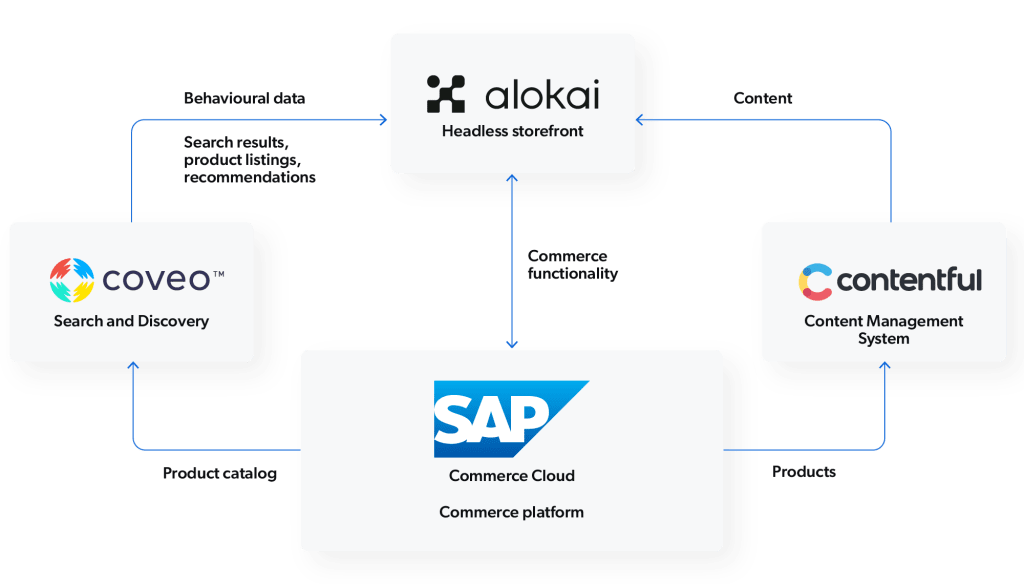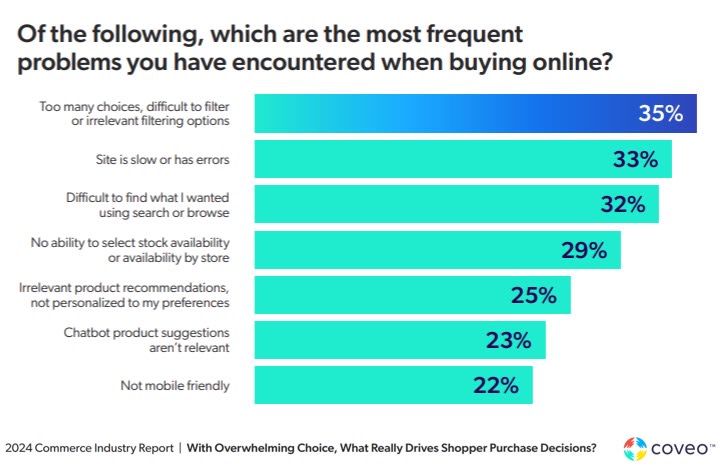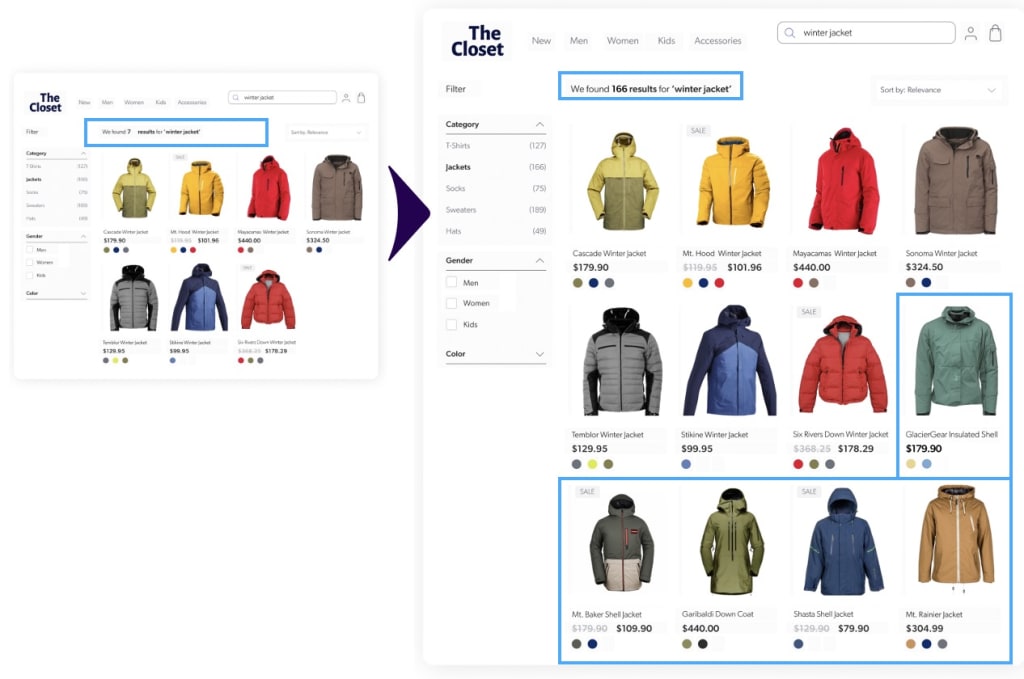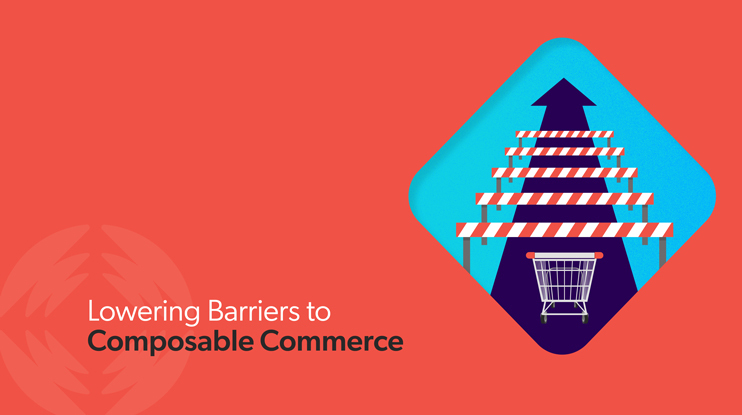Let’s start with a brief history of commerce architecture. Initially, all-in-one digital platforms, nowadays known as monoliths, dominated the market by providing everything businesses needed to quickly start selling online. However, as digital commerce grew, consumer expectations shifted, new channels and digital interfaces appeared, and the need for a more flexible approach became apparent.
An explosion of touchpoints with the rise of mobile commerce, social media shopping and virtual assistants, like Alexa and Google Home, made it clear that the traditional, monolithic approach couldn’t keep up. Businesses needed a more adaptable architecture, making way for headless commerce – decoupling front end from the backend – so that businesses could quickly integrate and manage these new interfaces while delivering consistent experiences.
As online shopping became the norm, this created opportunities for new brands to quickly enter the market. Competition intensified and businesses needed to differentiate with superior customer experiences driven by AI and personalization.
Enter composable commerce — a strategy that allows companies to tailor their digital ecosystems with best-of-breed solutions, creating a dynamic, modular architecture. This approach not only empowers businesses to innovate quickly but also to scale and evolve as market demands change.
Traditional monolith platforms recognize the need for this transition and are offering alternative approaches to help their customers move towards a more composable future. For example, SAP Commerce Cloud is achieving this together with a specialized partner network. At Coveo, we’re proud to be SAP’s endorsed vendor for AI-powered search and discovery, helping customers realize ROI from composability.
Let’s delve into the unique advantages of this approach to help you make the right choice that aligns with your business goals.
Keeping Up With Shopper Expectations
Transitioning to a composable commerce architecture is closely followed by the topic of replatforming. If you’re starting anew, MACH (Microservices, API-first, Cloud-native, and Headless) provides an excellent architecture standard. You have the flexibility to integrate best-in-class solutions and build a solution tailored to your business needs. You’re not limited by the constraints of a single platform, instead you can innovate and scale in the areas that matter most to your business.
However, replatforming requires careful consideration at the enterprise level. The initial expense of bringing together multiple tools can be significant, and there’s the steep learning curve associated with mastering new technologies. If you don’t invest in upskilling your team, they’ll quickly revert to old habits. Additionally, these projects can easily stretch into multi-year endeavors, with any delays resulting in further costs, as you need to maintain two systems simultaneously. For many enterprises, this level of disruption and cost isn’t viable.
An alternative, more realistic approach is to retain your existing infrastructure while modernizing key areas in line with your business strategy, using the Strangler pattern for example. You could move by gradually extracting features and creating a new application around the existing system
Coveo and SAP Commerce Cloud: A Balanced Approach
Take SAP Commerce Cloud, it’s a robust platform that offers a range of sophisticated features that many businesses rely on and can’t afford to lose when transitioning to a composable architecture. For instance, its complex pricing and entitlements capabilities allow you to manage customer-specific pricing rules effectively. It also excels in managing inventory across multiple warehouses, ensuring seamless operations and accurate stock levels across your entire supply chain. There’s also support for the complex buying processes typical in B2B. Managing accounts with multiple buyers, handling purchase orders, linking to cost centers, and setting up auto-replenishment orders — all vital for streamlining operations and maintaining customer satisfaction.
Rather than compromising these powerful capabilities, the goal is to retain the strengths of SAP Commerce Cloud while specializing other components through composable best-of-breed vendors. This balanced approach minimizes risk and allows you to realize ROI sooner by addressing your biggest pain points first. You can then build on these early wins and secure company buy in to continue your composable commerce journey investment.

Ultimately, there’s no one-size-fits-all approach. But by assessing your current challenges and business goals, you’ll be able to figure out the most viable path for your business to achieve the outcomes you want with composable commerce.
SAP Support for Composability
SAP is fully embracing this movement assisting customers in their composability transformation. One key SAP functionality is the Omni Commerce Connect (OCC) module. This allows any storefront, mobile app, or Point of Sale (POS) system to connect seamlessly to SAP Commerce Cloud and act as a ‘head’. By providing an API representation of the platform’s commerce capabilities—previously only accessible through tightly coupled accelerator storefronts (more on that later)—OCC enables businesses to leverage the full power of SAP Commerce Cloud in a headless architecture. This flexibility allows businesses to create and manage diverse customer experiences across various digital touchpoints.
Another significant step SAP has taken to support composability is the decoupling of SAP storefronts from the platform. Historically, SAP Commerce Cloud came bundled with pre-built storefronts as part of their ‘Accelerators’. While effective, these were closely integrated with the backend, limiting the flexibility businesses had to innovate. Recognizing the need for greater agility, SAP introduced SAP Commerce Cloud Composable Storefront (formerly known as Spartacus). This standalone, open-source frontend application is built using Angular and is designed to replicate and extend the functionalities of the standard accelerators. By decoupling the frontend from the backend, SAP Commerce Cloud enables businesses to create more customized and responsive digital experiences while still leveraging the robust commerce capabilities of the platform.
However, despite these advancements, SAP Commerce Cloud’s complex architecture and proprietary protocols can make integrating any external vendor challenging. Custom development and deep knowledge of SAP’s integration framework are often required. To overcome this challenge, SAP has partnered with leading vendors across various industries, streamlining the process of integrating best-of-breed solutions and reaping the benefits of composability.
At Coveo we play a key role in SAP’s partner strategy by being the only endorsed partner for AI-powered search and discovery. Search is one of the first areas that businesses prioritize in their composable strategy given its crucial role in the purchasing journey. If you’re facing issues like high volume of “no results” searches despite offering relevant products, high costs in terms of employee time spent curating product ranking, and low conversion rates, then investing in a new search solution will be top of the agenda.
Poor search functionality can severely impact the customer experience, leading to lost sales and decreased customer satisfaction. In fact, a consistent finding in our annual commerce industry report, is that 91% of customers expect the online buying experience to be better than, or equal to, the traditional in-store experience. Yet issues still regularly plague retailer sites, delivering a sub-optimal experience and disappointing customers – notably site navigation and search problems which 50% of shoppers say they frequently encounter when buying online.

Recognizing this, Coveo has worked closely with SAP to integrate seamlessly with its new search service framework, offering a connector that simplifies the integration. This partnership allows businesses to quickly modernize their search capabilities, providing a more intuitive and effective search experience that drives conversions and significantly boosts your bottom line.
Benefits of Composable Search
So what benefits can you expect with Coveo? First and foremost, Coveo’s AI hybrid search combines lexical (keyword search) with semantics (vector-based similarity search), layered with AI models to automatically optimize the ranking over time. Coveo makes results more relevant without your shoppers needing to be experts in your brand’s nomenclature, and this only gets better over time reducing the dependency on your team fine tuning with rules, so they can spend more time being strategic.
Coveo’s relevant search results also adapt to the individual’s in-session behavior. For instance, imagine two shoppers searching for gloves on your site. One shopper, who was previously browsing coats, should be shown more winter gloves. Meanwhile, another shopper who was looking at golf clubs should see golf gloves higher up. Personalizing to the individual’s intent ensures that each shopper sees the most relevant products at the right time, dramatically increasing the likelihood of conversion and boosting overall sales.

Coveo and SAP in Action
Australia’s largest supplier of industrial and safety products, Blackwoods, is a great example of driving incremental value by integrating Coveo with SAP Commerce Cloud. The company, Australia’s largest supplier of industrial and safety products, launched its new digital storefront on SAP leveraging best in class B2B features to help grow the amount of revenue going through its online store by 66%. Blackwoods continued modernizing its stack by integrating Coveo, resulting in a 44% reduction in no search results and a 70% uplift in add-to-carts from optimized product listing pages through AI-powered product discovery delivered by Coveo.
It’s no surprise with results like this that Noshir Jariwala, Digital Product Manager at Blackwoods, described “having Coveo integrated into SAP Commerce is like a match made in heaven”.
Enterprises are more than just selling products though, and Coveo’s capabilities extend to other critical business areas, such as customer service. Enterprises can leverage Coveo’s AI to enhance self-service portals, reducing the strain on customer support teams by providing accurate, context-aware answers to customer questions.
Subscribing to Innovation
But the best part of a modern, composable product like Coveo, is that you aren’t just buying today’s capabilities, you are subscribing to future innovation. A prime example of this is how Coveo became the first search vendor to release enterprise-ready generative answering. This innovation was swiftly rolled out to existing customers, giving them an instant competitive advantage whilst others were figuring out how to adopt GenAI.
Xero, a Coveo customer, deployed generative answering on their self-service portal within just six weeks. Better, it had an astounding impact, reducing the number of support cases submitted by 20%, showcasing how quickly and effectively Coveo can drive real business impact.
Final Thoughts
In summary, transitioning to a composable commerce architecture offers businesses the flexibility and agility needed to stay competitive in today’s dynamic market. SAP Commerce Cloud customers are offered an alternative approach through integrating best-of-breed endorsed partners like Coveo without sacrificing core functionalities. Coveo’s AI-powered search and discovery capabilities not only drive higher conversion rates and revenue but also reduce operational costs and support broader enterprise needs. As you embark on your composable journey, choosing the right tools and partners will ensure your business is well-positioned for future growth.


